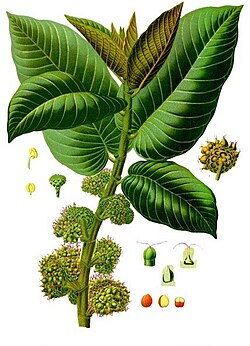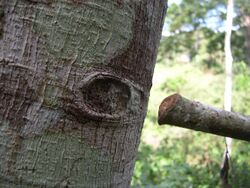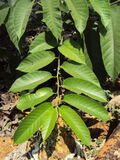Biology:Castilla (plant)
| Castilla | |
|---|---|

| |
| Castilla elastica | |
| Scientific classification | |
| Kingdom: | Plantae |
| Clade: | Tracheophytes |
| Clade: | Angiosperms |
| Clade: | Eudicots |
| Clade: | Rosids |
| Order: | Rosales |
| Family: | Moraceae |
| Tribe: | Castilleae |
| Genus: | Castilla Cerv. |
| Species | |
|
See text | |
| Synonyms | |
|
Castilloa (lapsus) | |
Castilla (sometimes incorrectly spelled Castilloa) is a genus of 3 species of large trees in the family Moraceae, native to Central and South America.[1]
Etymology
This genus is named after Juan Diego del Castillo (d. 1793), a Spanish botanist who was a friend of Vicente Cervantes, who chose the name in his friend's honor.[2][3]
Description
Castilla species are monoecious or dioecious trees up to 40 meters tall, with buttressed trunks and abundant white latex of commercial value.[1] The branchlets have scars left by the fallen stipules. The leaves are oblong to elliptic, with entire margins.[1][4] The inflorescences are surrounded by bracts and have small flowers. The male flowers are borne in lengthwise-folded kidney-shaped inflorescences and female flowers in globose inflorescences.[1][4] The infrutescence varies in shape and has orange or red fruits.[1]
Ecology

Castilla species exhibit a phenomenon known as cladoptosis, the regular shedding of branches. This may be an adaptation to prevent the growth of climbing plants.[5]
Castilla elastica is a weedy tree which has become invasive in areas where it has been introduced, such as in Tanzania and the South Pacific.[4][6]
Uses
The main species is Castilla elastica, one of several plants from which rubber has been extracted. The vernacular name is Panama rubber tree or castilloa rubber. The pre-Columbian MesoAmericans used the latex of this plant to make a ball used in a ceremonial game.
The Miskitu and Mayangna peoples of the Mosquito Coast, stretching from the Honduras to Nicaragua, traditionally made fabric from the bark of the Tunu rubber tree (Castilla tunu).[7]
Species
| Image | Common Name | Scientific name | Distribution |
|---|---|---|---|
 |
Panama rubber tree, Castilloa rubber, palo de hule, olicuáhuitl | Castilla elastica Sessé | Mexico, Central America, and northern South America |
| Castilla tunu Hemsl. | Ecuador, Colombia, Panama, Belize | ||
| Caucho rubber, Caucho Negro | Castilla ulei Warb. | Brazil, Bolivia, Peru, Ecuador and Colombia |
See also
References
| Wikimedia Commons has media related to Castilla. |
- ↑ 1.0 1.1 1.2 1.3 1.4 Cardona–Peña, Victor; Fuentes, Alfredo; Cayola, Leslie (2005). "Las moráceas de la región de Madidi, Bolivia" (in es). Ecología en Bolivia. http://www.mobot.org/mobot/research/madidi/pdf/07morceas40-3.pdf. Retrieved 23 May 2016.
- ↑ González, J.. "Explicación Etimológica de las Plantas de La Selva" (in es). http://sura.ots.ac.cr/florula4/docs/ETIMOLOGIA.pdf.
- ↑ Loadman, John (2005). Tears of the Tree: The Story of Rubber –a Modern Marvel. Oxford University Press. pp. 25. ISBN 9780198568407. https://archive.org/details/tearstreestoryru00load.
- ↑ 4.0 4.1 4.2 "Castilla elastica (PIER species info)". http://www.hear.org/pier/species/castilla_elastica.htm.
- ↑ Berg, C.C. (1977). "Castilleae, a tribe of the Moraceae, renamed and redefined due to the exclusion of the type genus Olmedia from the Olmedieae". Acta Botanica Neerlandica: 75. http://repository.naturalis.nl/document/572672. Retrieved 23 May 2016.
- ↑ "Castilla elastica (Panama Rubber Tree)". BioNET-EAFRINET. http://keys.lucidcentral.org/keys/v3/eafrinet/weeds/key/weeds/Media/Html/Castilla_elastica_%28Panama_Rubber_Tree%29.htm.
- ↑ Chavez Helm, Jasmine. "Tunu: A cloth of necessity, spirituality & resistance". The Critical Pulse SDU. https://issuu.com/thecriticalpulse/docs/tcp_issue_6/s/17895041.
Wikidata ☰ Q1924893 entry
 |

